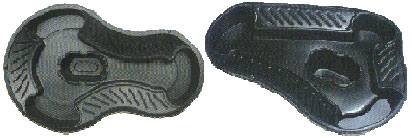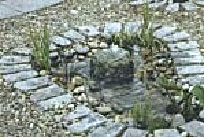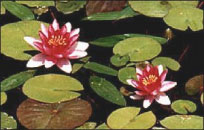In the past few years, there has been a growing trend to produce a more natural landscape in the garden. The sight and sounds of water often serve to top off this natural setting. Before embarking on making a pond, ertain decisions must be made in advance; careful planning will save a lot of time and frustration.
- Where is the pond going to go?
- What is it going to be made of?
- What do you want in the pond?
- Do you need a filter?

PLACEMENT: Ponds can be placed in full sun or slightly shaded areas. It would be advisable to place the pond in a position where it will not receive too much mess from large bushes or trees. If young children frequent the area, consideration must be given to the depth of the pond for their safety!
 TYPES OF PONDS: Pre-formed fibreglass or Poly ponds which come in a variety of shapes (though tend to be small), are durable and one of the easiest types of ponds to install. Plastic lined ponds are a cheaper alternative, but difficult however to form a neat, contoured pond due to the number of folds required. Plastic liners are best suited for larger, simple square or round shapes where no pre-formed units are available. If you wish to have a self-designed, highly contoured pond, then concrete is the answer. If an acrylic sealer such as “Wet-Look” is added to the cement (with an added damp course) and it is reinforced properly, then you will have a permanent, long lasting feature in your garden.
TYPES OF PONDS: Pre-formed fibreglass or Poly ponds which come in a variety of shapes (though tend to be small), are durable and one of the easiest types of ponds to install. Plastic lined ponds are a cheaper alternative, but difficult however to form a neat, contoured pond due to the number of folds required. Plastic liners are best suited for larger, simple square or round shapes where no pre-formed units are available. If you wish to have a self-designed, highly contoured pond, then concrete is the answer. If an acrylic sealer such as “Wet-Look” is added to the cement (with an added damp course) and it is reinforced properly, then you will have a permanent, long lasting feature in your garden.
FISH: There are basically four ways you can decide on fish. The first is KOI CARP. Koi can grow over two feet in length, so a large pond would be recommended. Also, they have the tendency to destroy plants, so it is not recommended to mix both together in the same pond. GOLDFISH only do little damage to plants, so a few goldfish in a well planted pond would make a good second choice. If you only want a small pond and you don’t like goldfish, then there are several species of small fish that you can also put in there. LIVEBEARING FISH such as guppies, mollies, platies and swordtails, require very little attention. They live on insects and graze on algae, but the cold of winter will force down their numbers until successive generations, resistant to the cold, continue to breed the numbers back up every summer. Or, if you want trouble free fish, then the small WHITECLOUD MINNOW is the easiest self-sustaining fish that you can keep. They will live entirely on insects that fall in the water and they are also fond of the dreaded mosquito larvae. The fourth choice is the natural method, keeping FROGS! This will increase the natural sounds in you garden (or drive you crazy at night). The whitecloud minnow can also be kept in the pond with them to keep the population of mosquitoes down.
PLANTS: If you have decided on not keeping Koi carp, then it should not be difficult to establish plants in your pond. By far the most popular plant is the WATER LILY. A wide range of colours are available but normally only during the warmer months. If they are kept in large pots and re-potted every few years with a little cow manure, then they won’t over-run your pond and they should flower frequently, especially in summer. There are many other plants available all year round which include fully submerged and some floating plants. Emergent plants can be planted in the shallows and around the outside edge of the pond in moist soil. Plants in the pond assist in minimising the chances of algae blooming in the pond. They do this by reducing the amount of light entering the pond and by absorbing the waste made by the fish.
 FILTERS: In well planted ponds with a low stocking density of fish, filters are not normally required. But if you have problems with cloudy water (either from dirt or algae), or you intend to have large numbers of fish, especially Koi and goldfish, then it is necessary to invest in a filter. There are several designs of filters on the market, each for different pond sizes and applications. An AQUOTIX staff member can show you the choices during your next visit. Quite often the cause of cloudiness in the water is caused by algae. There are several ways of removing the algae, this is outlined in another free handout from AQUOTIX called "Pond Maintenance and Algae Control" There is more than one way to make a garden pond. Before you make any final decisions get advice from more than one person, especially friends who have already got a pond. The biggest secret of a successful pond is to disturb it as little as possible. Ponds are not normally well established for a couple of years. Once nature takes its course and an equilibrium is reached, then the crystal clear pond will blend in with the natural landscape of your garden.
FILTERS: In well planted ponds with a low stocking density of fish, filters are not normally required. But if you have problems with cloudy water (either from dirt or algae), or you intend to have large numbers of fish, especially Koi and goldfish, then it is necessary to invest in a filter. There are several designs of filters on the market, each for different pond sizes and applications. An AQUOTIX staff member can show you the choices during your next visit. Quite often the cause of cloudiness in the water is caused by algae. There are several ways of removing the algae, this is outlined in another free handout from AQUOTIX called "Pond Maintenance and Algae Control" There is more than one way to make a garden pond. Before you make any final decisions get advice from more than one person, especially friends who have already got a pond. The biggest secret of a successful pond is to disturb it as little as possible. Ponds are not normally well established for a couple of years. Once nature takes its course and an equilibrium is reached, then the crystal clear pond will blend in with the natural landscape of your garden.
If ever you run into trouble or you just can’t seem to find what you need, just visit the AQUOTIX showroom for friendly professional advice and find our fully comprehensive selection of pond and aquarium goods.
